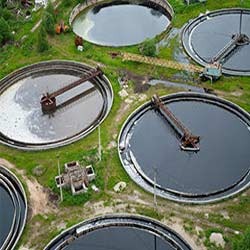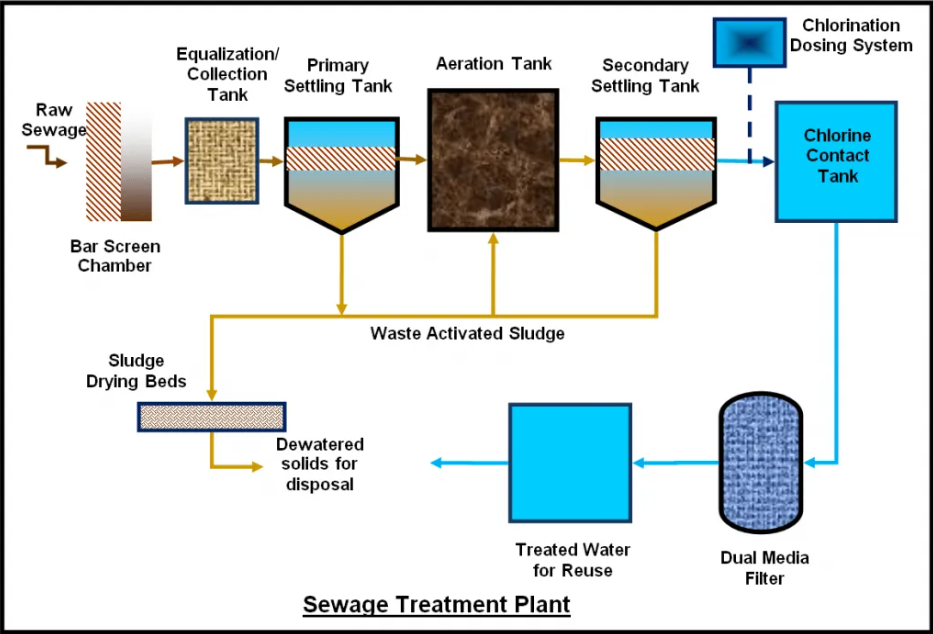3S-GSC
Sewage Treatment Plants

Water Treatment
Sewage Treatment Plants
A sewage treatment plant, also known as a wastewater treatment plant, is a facility designed to treat and process sewage and other wastewater to remove pollutants and contaminants before releasing the treated water back into the environment. These plants are critical to public health and the environment, as untreated sewage can cause water pollution and pose a risk to human health.
Sewage treatment plants typically use a combination of physical, chemical, and biological processes to treat wastewater. The exact treatment process can vary depending on the type and volume of wastewater being treated.
Sewage Treatment Plants typically include the following stages
Preliminary treatment
This stage involves the removal of large particles and debris, such as rocks, sticks, and other materials that can damage equipment or interfere with the treatment process.
Primary treatment
During this stage, solids are separated from the wastewater through a process called sedimentation. The solids settle to the bottom of a tank, where they are removed and sent for further processing or disposal.
Secondary treatment
This stage involves the biological treatment of the wastewater, where microorganisms are used to break down organic matter and nutrients. This process can be achieved through various methods, including activated sludge, trickling filters, or membrane bioreactors.
Disinfection
This final step involves the use of chemicals, UV light, or other methods to disinfect the treated wastewater before it is released back into the environment.
Sewage treatment plants can vary in size, capacity, and design depending on the specific needs of the community or facility they serve. They are typically operated and maintained by trained professionals and are subject to strict regulatory standards to ensure they meet the required water quality standards. Sewage treatment plants play a vital role in protecting public health and the environment by treating and processing wastewater in a safe and effective manner.
SEWAGE TREATMENT PLANTs Designs

DIFFERENT DESIGNS OF SEWAGE TREATMENT PLANTS
There are several different designs of sewage treatment plants, each of which uses different processes and technologies to treat and process wastewater. The specific design of a sewage treatment plant depends on a variety of factors, including the volume and characteristics of the wastewater being treated, as well as the regulatory and environmental requirements of the local area.
Conventional activated sludge plant
This is the most common type of sewage treatment plant, which uses aeration tanks to provide oxygen to microorganisms that break down organic matter in the wastewater. The treated water is then clarified by settling, and any remaining solids are removed in a final sedimentation tank.
Extended aeration plant
This type of plant is similar to the conventional activated sludge plant, but it operates at a lower hydraulic loading rate and has a longer aeration time. This results in a smaller sludge production and can be more energy-efficient.
Membrane bioreactor (MBR) plant
This type of plant uses a combination of activated sludge and membrane filtration to remove contaminants from the wastewater. The membranes act as a barrier to remove particles and bacteria, resulting in high-quality treated water that is suitable for reuse.
Sequencing batch reactor (SBR) plant
This type of plant uses a single tank to perform all of the treatment processes, including aeration, settling, and decanting. The wastewater is treated in batches, allowing for greater flexibility and control over the treatment process
Moving bed biofilm reactor (MBBR) plant
This type of plant uses suspended plastic media to provide a surface area for microorganisms to grow and break down organic matter. The wastewater passes through the media, and any remaining solids are removed in a sedimentation tank.
Constructed wetland plant
This type of plant uses natural processes to treat wastewater by passing it through a series of wetland cells, where the water is purified by natural vegetation, bacteria, and other microorganisms.
COME & TRY OUR SERVICES
contact us for more detail
